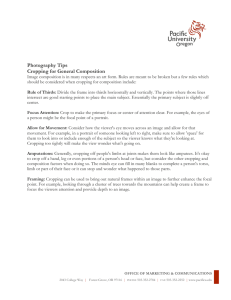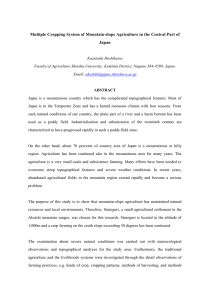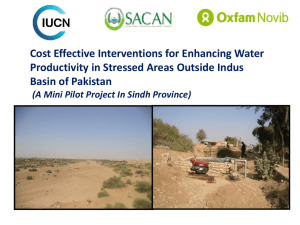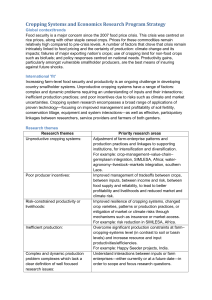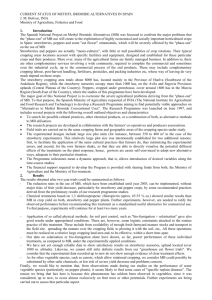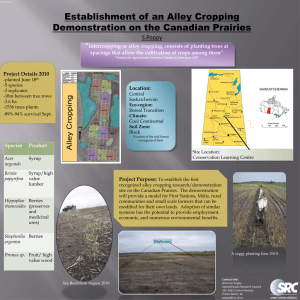ISPRS Archives XXXVIII-8/W3 Workshop Proceedings: Impact of Climate Change on... A SPATIAL DATABASE OF CROPPING SYSTEM AND ITS CHARACTERISTICS
advertisement
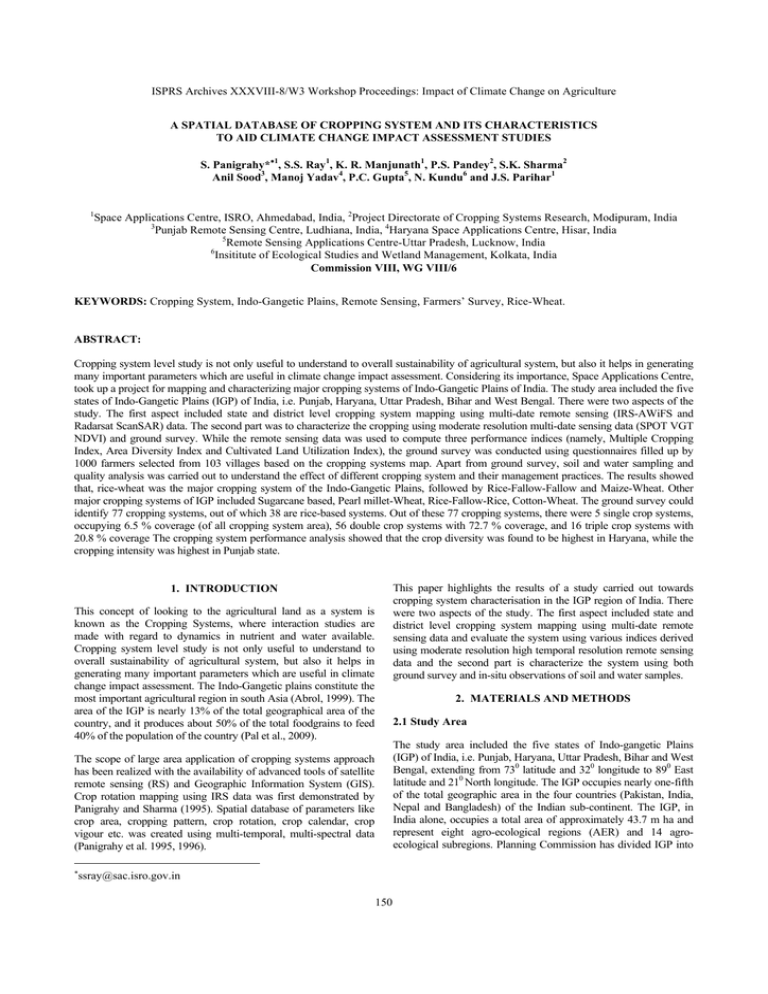
ISPRS Archives XXXVIII-8/W3 Workshop Proceedings: Impact of Climate Change on Agriculture A SPATIAL DATABASE OF CROPPING SYSTEM AND ITS CHARACTERISTICS TO AID CLIMATE CHANGE IMPACT ASSESSMENT STUDIES S. Panigrahy*∗1, S.S. Ray1, K. R. Manjunath1, P.S. Pandey2, S.K. Sharma2 Anil Sood3, Manoj Yadav4, P.C. Gupta5, N. Kundu6 and J.S. Parihar1 1 Space Applications Centre, ISRO, Ahmedabad, India, 2Project Directorate of Cropping Systems Research, Modipuram, India 3 Punjab Remote Sensing Centre, Ludhiana, India, 4Haryana Space Applications Centre, Hisar, India 5 Remote Sensing Applications Centre-Uttar Pradesh, Lucknow, India 6 Insititute of Ecological Studies and Wetland Management, Kolkata, India Commission VIII, WG VIII/6 KEYWORDS: Cropping System, Indo-Gangetic Plains, Remote Sensing, Farmers’ Survey, Rice-Wheat. ABSTRACT: Cropping system level study is not only useful to understand to overall sustainability of agricultural system, but also it helps in generating many important parameters which are useful in climate change impact assessment. Considering its importance, Space Applications Centre, took up a project for mapping and characterizing major cropping systems of Indo-Gangetic Plains of India. The study area included the five states of Indo-Gangetic Plains (IGP) of India, i.e. Punjab, Haryana, Uttar Pradesh, Bihar and West Bengal. There were two aspects of the study. The first aspect included state and district level cropping system mapping using multi-date remote sensing (IRS-AWiFS and Radarsat ScanSAR) data. The second part was to characterize the cropping using moderate resolution multi-date sensing data (SPOT VGT NDVI) and ground survey. While the remote sensing data was used to compute three performance indices (namely, Multiple Cropping Index, Area Diversity Index and Cultivated Land Utilization Index), the ground survey was conducted using questionnaires filled up by 1000 farmers selected from 103 villages based on the cropping systems map. Apart from ground survey, soil and water sampling and quality analysis was carried out to understand the effect of different cropping system and their management practices. The results showed that, rice-wheat was the major cropping system of the Indo-Gangetic Plains, followed by Rice-Fallow-Fallow and Maize-Wheat. Other major cropping systems of IGP included Sugarcane based, Pearl millet-Wheat, Rice-Fallow-Rice, Cotton-Wheat. The ground survey could identify 77 cropping systems, out of which 38 are rice-based systems. Out of these 77 cropping systems, there were 5 single crop systems, occupying 6.5 % coverage (of all cropping system area), 56 double crop systems with 72.7 % coverage, and 16 triple crop systems with 20.8 % coverage The cropping system performance analysis showed that the crop diversity was found to be highest in Haryana, while the cropping intensity was highest in Punjab state. This paper highlights the results of a study carried out towards cropping system characterisation in the IGP region of India. There were two aspects of the study. The first aspect included state and district level cropping system mapping using multi-date remote sensing data and evaluate the system using various indices derived using moderate resolution high temporal resolution remote sensing data and the second part is characterize the system using both ground survey and in-situ observations of soil and water samples. 1. INTRODUCTION This concept of looking to the agricultural land as a system is known as the Cropping Systems, where interaction studies are made with regard to dynamics in nutrient and water available. Cropping system level study is not only useful to understand to overall sustainability of agricultural system, but also it helps in generating many important parameters which are useful in climate change impact assessment. The Indo-Gangetic plains constitute the most important agricultural region in south Asia (Abrol, 1999). The area of the IGP is nearly 13% of the total geographical area of the country, and it produces about 50% of the total foodgrains to feed 40% of the population of the country (Pal et al., 2009). 2. MATERIALS AND METHODS 2.1 Study Area The study area included the five states of Indo-gangetic Plains (IGP) of India, i.e. Punjab, Haryana, Uttar Pradesh, Bihar and West Bengal, extending from 730 latitude and 320 longitude to 890 East latitude and 210 North longitude. The IGP occupies nearly one-fifth of the total geographic area in the four countries (Pakistan, India, Nepal and Bangladesh) of the Indian sub-continent. The IGP, in India alone, occupies a total area of approximately 43.7 m ha and represent eight agro-ecological regions (AER) and 14 agroecological subregions. Planning Commission has divided IGP into The scope of large area application of cropping systems approach has been realized with the availability of advanced tools of satellite remote sensing (RS) and Geographic Information System (GIS). Crop rotation mapping using IRS data was first demonstrated by Panigrahy and Sharma (1995). Spatial database of parameters like crop area, cropping pattern, crop rotation, crop calendar, crop vigour etc. was created using multi-temporal, multi-spectral data (Panigrahy et al. 1995, 1996). ∗ ssray@sac.isro.gov.in 150 ISPRS Archives XXXVIII-8/W3 Workshop Proceedings: Impact of Climate Change on Agriculture NDVI data to discriminate different cropping systems of Northern China. Sakamoto et al. (2006) developed a Wavelet-based Filter for evaluating the spatial distribution of Cropping Systems (WFCS) to the interpretation of MODIS time-series data four Agro-Climactic Zones (Figure 1), namely Trans-Gangetic Plains (TGP), Upper Gangetic Plains (UGP), Middle Gangetic Plains (MGP) and Lower Gangetic Plains (LGP). In this study, multidate image classification was carried out for generating seasonal cropping patterns. The classification was conducted in following steps: i) Removal of non-agricultural classes by using a non-crop mask by selecting appropriate thresholding of temporal NDVI ii) crop classification using multidate data with both unsupervised and supervised classifier. SAR data was clkassified using a decision rule classifier in backscatter domain to classify rice and other crops. The cropping pattern maps were generated using a logical combination of classified images corresponding to crops grown in a season. The crop rotation map was generated by logical combination of the three seasonal cropping pattern maps (Panigrahy & Sharma, 1995). 2.3.2 Cropping System Characterization using RS Data: Characterization of cropping system is essential for studying the sustainability of a cropping system by knowing its benefits and losses. Different cropping system efficiency indices were computed for characterizing the cropping system of the states of Indogangetic plains. Three indices, namely Multiple Cropping Index (MCI), Area Diversity Index (ADI) and Cultivated Land Utilization Index (CLUI) were computed. MCI measures the cropping intensity (Dalrymple, 1971), ADI measures the multiplicity of crops or farm products, which are planted in a single year (Strout, 1975; Wang and Yu, 1975) and CLUI measures how efficiently the available land area has been used over the year (Chuang, 1973). The details of the computation is as given by Panigrahy et al. (2005). Figure 1. Map showing Agroclimatic Regions and Sub-regions of Indo-Gangetic Plains The IGP is mostly dominated by the loam soil except for the southwestern parts of Punjab and Haryana having sandy soil which also coincides with low rainfall. The net irrigated area ranges between 35 percent in West Bengal to 95 percent in Punjab as per the land use statistics brought out by Ministry of Agriculture. Rice and wheat are the most important crops in the IGP. The total reported area of rice-wheat cropping system (RWS) in IGP is around 9.64 million ha. 2.2 Data Use IRS Advanced Wide Field Sensor (AWiFS) data acquired from October 2004 to May 2005 were used in this study to map the crops grown in Rabi (winter) and summer season. Due to cloud cover problem, microwave data of ScanSAR Narrow Beam-2 (SN2) of RADARSAT was used to map the Kharif (rainy) season cropping pattern. The 10-day composite (S10) NDVI (Normalized Difference Vegetation Index) product of SPOT Vegetation (VGT) sensor was used for deriving cropping system indices. Thirty-nine dates’ data were used from 1st May 2004 to 31st May 2005. The other data were ground truth collected for each crop in each state to classify the satellite data. Another set of major data for the projects was collected using survey of 1000 farmers in 100 villages and soil and water sampling in these villages. 2.3.2.1 Duration of Crop Rotation: Duration of each crop rotation was computed using high temporal resolution data of SPOT Vegetation (VGT) sensor. The remote sensing data used in this study included the 10-day maximum value composite of NDVI products derived from VEGETATION sensor of SPOT-4 satellite. The NDVI profile for each cropping system in an agro-ecological sub-region, was fitted using a 5th order polynomial. From this fitted model the beginning and dates of cropping cycles were computed, which can be considered the spectral emergence and spectral maturity date. In order to compute the total duration (di) of a cropping system 10 days were added at the beginning (15 days for rice crop) and 10 days at the end of each crop-growing period. These days account for the duration of field preparation, the gap between sowing and spectral emergence and the gap between spectral maturity and the harvest of the crop. 2.3 Methodology 2.3.1 Crop Rotation Mapping: This methodology of cropping system mapping is primarily based on the use of digital image analysis technique and geographic information system. Various components of the methodology are: i) Designing of remote sensing (RS) database, ii) pre-processing of RS data, iii) preparation of registered dataset using temporal data, iv) creating temporal dataset, v) image classification etc. 2.3.3 Cropping System Characterization using Ground Survey: Characterization includes creating a database of variant and invariant resources and integrating the management practice, socioeconomic aspects. Characterization of the cropping systems requires knowledge of the actual management practice followed by farmers. This requirement is fulfilled by field survey of the area, interviewing the farmers, taking measurements of productivity etc. A stratified sampling method was followed for farmers’ survey. The total agricultural area of the Indo-Gangetic plains is the sampling frame. This is further stratified based on the major Various approaches have been used by different workers for multidate image classification for cropping pattern. Mingwei et al. (2008) used Fourier analysis method, and time-series EOS-MODIS 151 ISPRS Archives XXXVIII-8/W3 Workshop Proceedings: Impact of Climate Change on Agriculture in UP. Fig. 4 shows the crop rotation map derived using remote sensing data for the states of Punjab, Haryana, UP and WB. cropping systems. Total 100 villages were selected in the region for survey. The allocation of the number villages for each cropping system and each state was proportional to the area occupied by that cropping system. Figure 2 shows the location and distribution pattern of the selected villages in the IGP. Minimum 10 farmers (3 farmers each from small, medium and large holding size) from each of the selected villages were interviewed. Secondary data on area, production and productivity of various crops at districts level from four sub regions of Indo-Gangetic Plain were used as auxiliary information to build up different estimates. Surface (0-15 cm) soil samples were collected from all the selected villages during the survey. These soil samples were analyzed for soil reaction, electrical conductivity, organic carbon and available nutrients (N, P and K). Similarly, water samples were also collected from selected villages for various sources of irrigation in respective zones. These samples were analyzed for parameters like electrical conductivity, pH, cations and anions. These data were used for computation of residual sodium carbonate, an indicator of sodicity hazard. The quality of irrigation water was adjudged on the basis of salinity and sodicity hazard. Figure 3. Major crop Rotations and Number of Rotations Observed in Agroclimatic Subregions of IGP Through Ground Survey 3.2 Cropping System Indices The cropping system performance analysis showed that the crop diversity was found to be highest in Haryana, while the cropping intensity was highest in Punjab state (Table 1). The Multiple Cropping Index (MCI) indicates the cropping intensity. It shows the number of crops grown temporally in a particular area over a period of one year. Most of the IGP states have high MCI except WB, which is as less as 143, as in most of its areas, early summer rice is taken, due to which the land remains fallow during the rabi season. Thus, analysis of net area sown and cropping pattern shows that, cropping intensity can be improved by incorporating a short duration crop in summer in the states of Punjab, Haryana, and in rabi season, in West Bengal. Figure 2. Location of survey villages in Indo-gangetic plains 3. RESULTS AND DISCUSSION Seasonal ADI computed using the RS based cropping patterns showed that in Punjab kharif season is more diversified than the rabi season. In rabi season, most of the area is under wheat crop. Haryana, in kharif, has registered the maximum diversity with ADI of 2.30 as about four crops are grown there in kharif. However, in the rabi season, Haryana has less ADI. West Bengal, however, exhibited high ADI in the rabi season. 3.1 Cropping System Data Base and Map The ground survey could identify 77 cropping systems, out of which 38 are rice-based systems. Out of these 77 systems, there were 5 single crop systems, occupying 6.5 % coverage (of all cropping system area), 56 double crop systems with 72.7 % coverage, and 16 triple crop systems with 20.8 % coverage. Maximum diversity of rotations was observed in the North western and southwestern subregions of UGP (Fig. 3). The Cultivated land utilization index (CLUI) is the measure of land utilization. For a cropping pattern, where the land remains unutilized for a very short period, the CLUI attains a value near to 1.0, whereas for a completely unutilized land (through out the year), the CLUI is 0.0. CLUI of Punjab was high due to the ricewheat and cotton-wheat rotations in a considerable area, which kept most of the arable land occupied for most of the days of the year. As against this, West Bengal has a less CLUI due to a single crop in most of the area. Mapping of rotations using satellite data could identify the major ones. The results showed that, rice-wheat, Rice-Fallow, CottonWheat and Maize-Wheat are some of the major ones in IGP. The other rotations mapped with good accuracy are Sugarcane based, Pearl millet-Wheat, Rice-Fallow-Rice, Cotton-Wheat. Rice-wheat is the major crop rotation in Punjab, Haryana and UP, while RiceFallow is the major rotation in West Bengal. The second major crop rotation of Punjab and Haryana are Cotton-Wheat, while that of UP and West Bengal are Sugarcane based system and Rice-Rice respectively. Coarse Cereal and Pulse based systems are observed 152 ISPRS Archives XXXVIII-8/W3 Workshop Proceedings: Impact of Climate Change on Agriculture States Punjab Haryana WB MCI 204 171 143 CLUI 0.80 0.66 0.41 ADI Kharif 2.23 2.30 1.31 of FYM was recorded maximum in rice-potato-vegetable system (15.0 t/ ha) followed by rice-potato-maize (14.0 t/ha), maize–wheat (12.8 t/ha), rice-potato-sunflower (12.5 t/ha) and maize-pea (10.7 t/ha) cropping systems. Rabi 1.60 1.76 4.76 Figure 6 shows the index of soil fertility and nutrient availability for different regions of Indo-gangetic plains. While majority of surface soil (99.5%) was deficient to low in available N and 0.5 % surface soil was medium in available N. About 23.5 % surface soil was deficient in available P, 64.1 % surface soils medium and 12.4 percent high in available soil P. While majority (69%) of surface soil was medium in available K, 15.3 % surface soil was high in available K. Table 1: Cropping system Efficiency Indices for Different States in IGP 3.3 Cropping System Characterization using Ground Survey Region level analysis of production under different cropping systems showed that the maximum system production was found in sugarcane -ratoon-wheat (191.3 million ton) followed by ricewheat cropping system i.e. (77.3 million ton), rice-sugarcane (42.7 million ton), rice-potato (41.2 million ton), sorghum (f)-berseem (27.9 million ton), maize-potato (22.8 million ton), cotton-wheat (12.3 million ton), sorghum (f)-wheat-sugarcane (10.9 million ton), ratoon-sugarcane and rice-mustard+sugarcane (both 10.8 million ton) and sorghum(f)-wheat (10.6 million ton). Sorghum (f)berseem, sorghum (f)-wheat-sugarcane, ratoon-sugarcane, ricemustard+sugarcane and sorghum (f)-wheat are not among the ten major cropping systems of IGP but their system production lies under ten largest production systems. It indicated that the sorghum (f), berseem, ratoon or sugarcane are the high yielding crops, hence the system production of these cropping systems is high as compared to other systems. CONCLUSION Climate change impact assessment studies have been generally been carried out on individual crops (Challinor and Wheeler, 2008; Lal et al., 1998; Tubiello and Ewert, 2002). However, the performance of individual crops will vary significantly, when they are evaluated as part of a system. Hence, for understanding the impact of climate change on agriculture, cropping systems need to be assessed. In this direction, simulation models have been developed and evaluated to understand the behaviour of cropping systems per se under different climate change scenarios (e.g. CropSyst, Tubiello et al., 2000). Apart from climate change impact, even the long-term sustainability of many cropping systems needs to be evaluated. Abrol (1999) found that over exploitation of groundwater resources and quality degradation are major concerns in sustaining high productivity of the rice-whet cropping system in the northwestern region of Indo-gangetic plans. Many studies are being carried out to sustain the productivity of different cropping systems in IGP which include diversification, improved land use and natural resource management (Aggarwal et al., 2004), resource conservation technologies (Gupta and Seth, 2007)\, etc. Figure 5 shows fertilizer use pattern in the first major cropping systems of different regions of Indo-Gangetic Plains. As shown, there is very high fertilizer use (151.4, 42.9, 6.7 kg/ha N, P, K) in TGP compared to other agro-ecological zone. LGP had the lowest fertilizer use (80.6, 20.7, 34.2 kg/ha N, P, K). Among the 1st major cropping systems nitrogen use was highest in cotton-wheat (307 kg/ha) and rice-wheat (238.8 kg/ha) cropping systems, phosphorus use was highest in Rice-wheat system (72.7 kg/ha) and potassium use was highest in rice-mustard-rice (102.9 kg/ha) system. Among all the cropping systems, the maximum use of nitrogen was recorded in five cropping systems, namely, rice-potato- vegetable (425.5 kg/ha) followed by rice-potato-muskmelon (415.5 kg/ha), rice-potato–sunflower (410.8 kg/ha), rice–potato–wheat (353.4 kg/ha), rice-potato-maize (333.5 kg/ha), cotton-wheat (307 kg/ha) and rice-wheat (238.8 kg/ha) cropping systems. Maximum use of phosphorus was recorded in rice-potato-muskmelon (126.5 kg/ha), followed by rice–potato–wheat (125.3 kg/ha), ricemustard+sugarcane (104 kg/ha), and rice–pea-wheat (103.5 kg/ha) and rice-wheat (72.7 kg/ha) cropping systems. Maximum use of potassium was recorded under rice-potato-rice (138.0 kg/ha) followed by rice-wheat-rice (124.9 kg/ha), rice-potato-jute (107.3 kg/ha), rice-mustard-jute (107 kg/ha), rice-mustard-rice (102.9 kg/ha) and rice-lathyrus-rice (101.7 kg/ha) cropping systems. Use In this context, the information related to the existing cropping system vis-à-vis their characteristics is essential. This present study has incorporated a unique combination of remote sensing data and detailed (stratified) ground survey to generate spatial database of different cropping systems of Indo-gangetic plains. It has been also been possible to characterize the cropping systems with respect to their diversity and land utilization capability. The cropping system information has been integrated with information related to soil nutrient level and water quality in order to understand the sustainability and ecological impact of different cropping systems. It is expected that, this dataset will form a background for many climate change impact assessment studies of Indo-gangetic plains, which is the food basket of India. 153 ISPRS Archives XXXVIII-8/W3 Workshop Proceedings: Impact of Climate Change on Agriculture Punjab West Bengal Haryana Figure 4. Crop Rotation Maps Derived using Remote Sensing Data for the States of Punjab, Haryana, UP and West Bengal Figure 5. First Major Cropping System of Indo-Gangetic Plains and their Corresponding Fertilizer use Uttar Pradesh 154 ISPRS Archives XXXVIII-8/W3 Workshop Proceedings: Impact of Climate Change on Agriculture NW India to future changes in climate Agricultural and Forest Meteorology, 89(2):101-114. Mingwei, Z., Qingbo, Z., Zhongxin, C., Liu, Z and Chongfa, C (2008) Crop discrimination in Northern China with double cropping systems using Fourier analysis of time-series MODIS data. Inter. J. Appl. Earth Observ. Geoinform. 10(4): 476-485. Pal, D. K., Bhattacharyya, T., Srivastava, P., Chandran, P. and Ray, S. K. (2009). Soils of the Indo-Gangetic Plains: their historical perspective and management. Curr. Sci. 96(9): Pandey, P.S., Koshal, A.K., Singh, J. and Subbarao, A.V.M. (2006). Geographic information system application in cropping systems analysis of Indo Gangetic Plains using ground based survey, J. Farming Syst. Dev. 12(1&2): 54-58. Panigrahy, S. and Sharma, S. A. (1997) Mapping of crop rotation using multidate Indian Remote Sensing Satellite digital data. ISPRS Journal of Photogram. Rem. Sens. 52(2): 85-91. Figure 6. Index of Soil Fertility and Nutrient Availability ACKNOWLEDGEMNT Panigrahy, S, Singh, R. P, Sharma S. A. and Chakraborty, M., (1995), Results of potential use of simulated IRS-1C WiFS data for crop monitoring., J. Ind. Soc. Rem. Sens., 23, 175-183, 1995. The study was carried out as part of the ISRO EOAM project on “Cropping System Analysis”. The authors are grateful to Dr. R. R. Navalgund, Director, SAC for his support and keen interest in the study. Panigrahy, S, Kundu, N, Pal, M, and Bose, S.C, (1996), Sustainability of the agricultural system in Bankura district, West Bengal: an integrated analysis of temporal IRS LISS-1 data. Science, Technology and Development, 14 (2), 26-38 REFERENCES Abrol, I. P. (1999) Sustaining rice–wheat system productivity in the Indo-Gangetic plains: water management-related issues. Agricul. Wat. Mgmt. 40(1): 31-35. Panigrahy, S., Manjunath, K.R. and Ray, S. S. (2005). Deriving cropping system performance indices using remote sensing and GIS. Int. J. Rem. Sens. 26(12): 2595-1606 Aggarwal, P.K., Joshi, P.K., Ingram, J.S.I., and Gupta. R.K. 2004. Adapting food systems of the Indo-Gangetic plains to global environmental change: key information needs to improve policy formulation. Environmental Science & Policy, 7(6): 487498. Sakamoto, T., Nguyen, N.V., Ohno, H., Ishitsuka, N. and Yokozawa, M. (2006) Spatio–temporal distribution of rice phenology and cropping systems in the Mekong Delta with special reference to the seasonal water flow of the Mekong and Bassac rivers. Rem. Sens. Environ. 100(1): 1-16. Challinor, A.J. and Wheeler, T.R. 2008. Crop yield reduction in the tropics under climate change: Processes and uncertainties. Agricultural and Forest Meteorology, 148(3): 343-356. Strout, A.M. (1975). Some definitional problems with multiple cropping diversification. Phil. Econ.Journal, 14: 308-316. Chuang, F.T. (1973). An analysis of change of Taiwan’s cultivated land utilization for recent years. Rural Econ. Div., JCRR Rep. 21, Taipei, Taiwan. Tubiello, F. N. and Ewert, F. 2002. Simulating the effects of elevated CO2 on crops: approaches and applications for climate change. European Journal of Agronomy, 18(1-2), 57-74. Dalrymple, D.F. (1971). Survey of multiple cropping in less developed nations. United States Department of Agriculture, Washington D.C. FEDS, 108 p. Tubiello, F. N., Donatelli, M., Rosenzweig, C. and Stockle, C. O. 2000. Effects of climate change and elevated CO2 on cropping systems: model predictions at two Italian locations. European Journal of Agronomy, 13(2-3): 179-189. Gupta, R. and Seth, A. 2007. A review of resource conserving technologies for sustainable management of the rice–wheat cropping systems of the Indo-Gangetic plains (IGP). Crop Protection, 26(3): 436-447. Wang, Y.T. and Yu, Y.H. (1975). Historical evaluation and future prospect for multiple crop diversification. Phil. Econ. J., 14: 26-46. Lal, M., Singh, K. K., Rathore, L. S., Srinivasan, G., Saseendran S. A. 1998. Vulnerability of rice and wheat yields in 155
